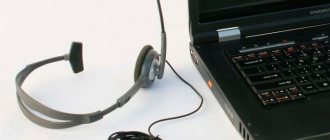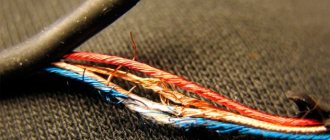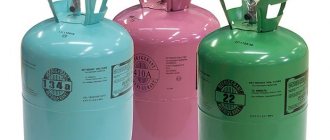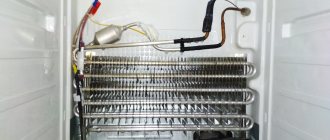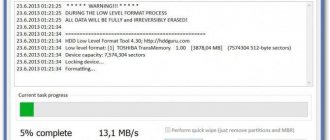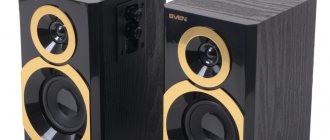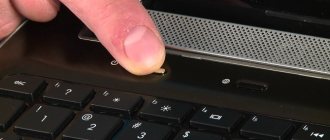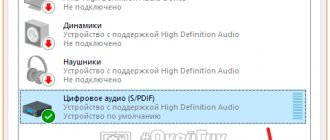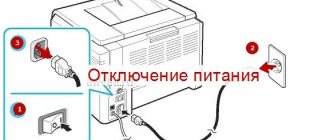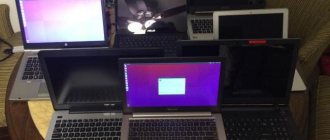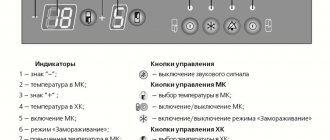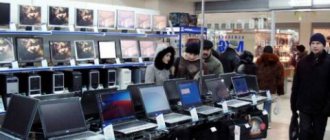Different drive file system
If the laptop does not see the SD card, it may be formatted in a file system that is not supported by Windows. But more often, when there is a file system conflict, the computer sees the SD card, but does not open it, but offers to format it. The solution in this case may be to format the card into a compatible FAT32 and save the files first. The most convenient way to do this is in disk managers, for example, in Paragon Hard Disk Manager
.
- After launching the program, connect the card;
- When it appears in the manager interface, create unallocated space on it for copied files;
- Create a partition with FAT32 in an empty area;
- Insert the card into a device that recognizes it and move the files to the created partition;
- Delete the partition with the unsupported file system in Paragon Hard Disk Manager and expand the FAT32 volume to fill the unallocated space.
Note: If you copied files using another method, you can format the entire SD card. In this case, you can use the program built into Windows (right-click on the flash drive in Explorer, select “ Format”
" in the context menu) or the command line utility
diskpart
.
Letter conflict
Another common reason why Windows 10 does not see the SD card is that the drive is automatically assigned an existing partition letter. Fixing this problem is not difficult.
- Go to disk management and find your card in it, focusing on its size and the absence of a letter;
- Right-click on it and select “Change drive letter or drive path” from the menu;
- In the window that opens, click “Add”, specify the appropriate letter in the new dialog box and click “OK
" After this, the drive will become available in Explorer.
Sometimes, instead of a letter, the drive may be assigned a symbol; in this case, the SD card will also not be visible, so instead of “Add” in the letter assignment dialog box, click “Change”.
Driver problem
When the computer does not see the SD card through the card reader, and it is not visible in disk management, it is worth checking whether everything is ok with the drivers.
- Go to Device Manager
and expand the “
Disk devices
” branch; - The presence of an unidentified device marked with a yellow icon will indicate that a corresponding driver is not available. In this case, go to the website of the computer motherboard manufacturer, download and install the driver for the card reader.
Beginner users can resort to DriverPack Solution
or other programs for automatically obtaining and updating drivers.
Device settings failure
Try resetting the device, since the reason that the system does not see the SD card may be some kind of malfunction in its driver.
- Go to Device Manager
and expand “
Disk Devices
”; - Click on the connected card with the right key of the manipulator and select “Delete
»; - Update the hardware configuration through the menu "Action
»;
If this doesn't help, reinstall the USB root hub that the SD card is connected to.
- On the menu "View
» Device Manager, select devices by connection; - Find your SD card in the list and see which rooted device it is connected to. This is usually a USB root hub;
- Remove the device and restart your computer to allow it to reinstall itself.
Prevention
It is better to use the flash drive correctly first so that later there are no problems with its malfunction. Here are some tips to help avoid MicroSD failures:
- Do everything possible to ensure that the drive is not dropped, knocked, bent, exposed to extreme temperature changes or other impacts that could damage it.
- Avoid ionizing radiation (such as from X-ray machines).
- Do not touch the contacts with your fingers and generally try to always keep them covered with a special cover.
- Defragment the card from time to time and generally use it regularly - MicroSDs don’t like to just sit on the shelf.
- Try to make backups from time to time so that in case of a breakdown you do not lose all your data. To do this, you can use cloud storage.
- Do not fill the entire storage capacity; let there always be some free space.
- If the card is in some device, try to remove it from there as often as possible.
Hardware problem
If the built-in card reader does not see the SD card, this may also indicate a hardware problem. Especially if it doesn't show up in Device Manager at all. Try connecting the media through an external card reader (if you have one) or insert the card into another PC. Successfully reading the drive will only confirm that there is something wrong with your built-in card reader. If the card is not readable on other devices, the problem is most likely in the card itself. It would not be superfluous to check the contacts and cable condition (when using an external card reader).
Recovering damaged MicroSD
In some cases, when using the drive, the message “Damaged memory card” or something similar may appear on the screen.
The following programs help here:
- Smart Data Recovery – you need to select the media and click the Find button, after which it will search for all files that can somehow be recovered;
- Recuva – when starting, you need to select the media and click on the “Analysis” button, wait for the process to complete and see a list of files available for recovery;
- BadCopyPro – click on Memory card on the left, then Next, Next again, wait for the process to finish and see the list of required files.
The same operations can be performed on a device running Android OS. The following applications help here:
- GT Recovery for Android (program for a phone or tablet) – select the desired item in the menu and wait for the process to complete;
- Wondershare Dr.Fone for Android (program for computer) – connect the device to the computer, launch the program, select the types of files that need to be recovered and wait.
Card file system corruption
A drive with a damaged file system appears in disk management, but the PC will not see the SD card. To identify errors and eliminate them, do the following:
- Open Command Prompt or PowerShell
; - Run the command chkdsk F: in it
, where F is the card letter; - If errors are found, run the command chkdsk F: /f /r
for correction.
Card detection disabled in BIOS
It's unlikely, but it may happen that your card reader is disabled in the BIOS. Look for a section in the BIOS with connected devices, most often it is called “Miscellaneous Devices” or “Onboard Devices”; the names of the card reader may also differ, for example, “SD Reader” or “Media Card Reader”. The setting responsible for enabling/disabling the card reader may also be located in the “System Configuration” section (see screenshot)
In all cases, the settings value should be set to “ Enable”
" If the BIOS does not recognize the SD card, the device itself may be damaged, but this is not necessary since the built-in microSD port may not be detected by the BIOS by default.
Problem: BIOS settings
When using this program, constant problems arise when reading removable media. But if you like the BIOS and don’t want to give it up, just adjust the settings.
- Check if the latest version is installed. If it becomes outdated, update the BIOS.
- Make sure the USB controller is ok. Its ports must be enabled and, most importantly, work in version 2.0. The main difference between USB versions is in the power supply level; in 1.0 it is much lower, which interferes with reading modern SDHC cards.
If everything is in order with the cable and software, but the memory card is still not readable, try inserting it into a laptop (usually it has a built-in card reader) of a compatible standard.
Files written to the card cannot be read
A slightly different situation arises when the SD card does not see the files written to it, but at the same time it itself is recognized by the system. The cause, again, may be damage to the drive’s file system. To fix file system errors we used chkdsk
, but if this tool does not help resolve the problem, you should use tools for recovering data from damaged media, such as
R-Studio
.
- After launching the program, select the connected drive and click on the toolbar "Scan
»; - Confirm the start of scanning in the dialog box that opens;
- Upon completion of the procedure, select the option “Found by signatures
" and then click the link "
Files found using information...
»; - Select the file types you need in the right column and click "Restore marked
»; - Specify the directory for copying data in the new dialog box and start the recovery procedure by clicking the "Yes
».
As for the memory card itself, it will most likely have to be formatted. It is possible that for this you will need third-party specialized software - HDD LOW Format
or
SDformatter
(if Windows can't handle the task).
Checking the flash card and card reader for serviceability
To check the flash drive for serviceability, just install it on another device.
If there is another card of the same model, check whether it is recognized on the computer. There are several reasons that affect the operation of a memory card: improper removal of the device, physical wear, or damage. In the first two cases, you can try to restore the functionality of the media using special low-level formatting utilities. Connecting the motherboard to the system unit
We use the HDD Low Level Format Tool utility:
- download the program;
- after launching the utility, select the drive model and click on the “ Continue ” button;
- go to the “ LOW-LEVEL FORMAT ” tab;
- a warning will appear indicating that all existing data will be deleted ;
- click "FORMAT THIS DEVICE» to start formatting.
We use the SDFormatter program to recover flash drives in SD, SDHC and SDXC formats:
- download, install and run the software;
- after launch, the program will initialize the connected devices;
- go to the “ Option ” tab to set formatting options;
- “ Quick ” - quick formatting, “ Full (Erase) ” - permanent deletion of data without overwriting and “ Full (Overwrite)” - complete deletion with overwriting;
- In the main program window, click “Format».
If the problem is with the card reader itself, then in this case you will need to contact a service center. If you need to use the drive immediately, purchase a special USB adapter equipped with a card reader; it can be connected to a laptop.
The problem may also arise due to incompatibility ; at the moment there are several types of flash drives: SD with byte addressing and SDHC with sector-by-sector addressing. To eliminate incompatibility, it is better to use a USB SD-MMC adapter . With it you can use several types of memory cards.
Bottom line
We will assume that in general we have answered the question “why the computer doesn’t see the SD card.” Of course, other reasons cannot be ruled out, but the above are the most typical. No one is immune from problems when working with memory cards, but they can be minimized by adhering to simple rules for operating drives of this type, in particular, keeping them clean, using the safe removal function and never using force when trying to insert the device into the card reader. It should also be taken into account that the memory cells of a card that is not used for a long time degrade relatively quickly, so at least once a week or two you need to supply power to it by connecting it to a computer.
Nutrition
Due to a performance issue, the power supply or battery may not be able to cope with the load and turn off the USB ports or reduce the power supplied to them. This especially often happens on laptops. Therefore, you need to change some parameters.
- In Start, type “Choose a power plan” or “Power plan” into the search bar. Open the settings.
- You should now see three diagrams. You need to select the “Set up power plan” link opposite the active one.
- "Change advanced power settings."
- Expand “USB Settings”, then click on “Option to temporarily disable USB port”. Set the “Value” (“On Mains” or “Battery”) as “Prohibited”. Click “Apply”.
